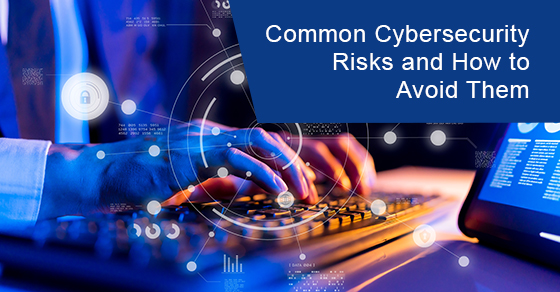
Common Cybersecurity Risks and How to Avoid Them
The COVID-19 pandemic has significantly changed how consumers shop and companies conduct their business. According to the International Trade Administration, 72.5% of the Canadian population shopped online in 2021, with retail sales of over $15.1 billion US just five months into the year. Now, retailers, manufacturing firms, and government organizations alike are increasingly likely to manage their daily operations online. However, a breeding ground for security risks and cybercrime comes with this digital migration. These cyberthreats are constantly evolving and finding new ways to breach digital vulnerabilities. As business owners, it’s now more important than ever to assess where your vulnerabilities are and take the necessary steps to protect your company. Here are the five most common cybersecurity risks and how you can combat them to keep your business safe.
Phishing
Phishing usually involves fraudulent emails or phone calls that are sent to your devices to steal sensitive information, such as bank account numbers, credit card information or passwords. Have you ever gotten an email that says “your account has been locked” or “strange activity has been detected in your account”? You may have been the subject of a phishing attempt. These emails or messages often have clickbait subject lines, a link to what looks like a legitimate website, or downloadable attachments. A phishing phone call may ask you to call a number back to discuss a strange problem with your account. You may then be asked to provide sensitive account details over the phone. To avoid falling for a phishing scam, make sure to watch out for the following:- If you do not recognize the sender’s email address or phone number
- If there are a lot of spelling and grammar mistakes
- If the sender asks for sensitive information
- If the offer sounds too good to be true
Malware
Malicious software, or “malware,” is any piece of software intended to harm. The installation of malware is usually the result of a phishing attack, for example, if you downloaded a file from a phishing email. You may also get malware from clicking on a pop-up ad or an infected link. Once malware is in your computer, the hacker may access your passwords, credit card information, client data, personnel files, and other sensitive information. To avoid malware, evaluate the safety of free software and peer-to-peer file sharing sites before downloading files. You may also consider installing an anti-malware program from a reputable provider to prevent malware attacks.Ransomware
Ransomware is malware that encrypts and blocks access to a computer system. To regain access, users will have to pay a ransom fee to the hacker. The ransom costs can range from hundreds to even millions of dollars. However, there are cases where the organization still cannot re-access their systems despite making the ransom payment. From healthcare to education, ransomware affects businesses in all industries. Unfortunately, as more people are working from home due to the global pandemic, cybercriminals have seized the opportunity to attack users working without protection from a corporate firewall. Much like other forms of malware, ransomware is typically released via infected links or downloads in phishing emails, file shares, and pop-ups.Password Theft
There are three ways a user’s login credentials may be compromised:- Unknowingly entering login details on a fake website
- Using common usernames and passwords that hackers can easily guess
- Reusing passwords across platforms
Data Breach
A data breach is when confidential data is stolen from the system. This may include credit card information, social security numbers, addresses, phone numbers, passwords, etc. From eBay to your local bookstore, businesses big and small are on the list of data breach victims. A data breach occurs either by physically accessing a computer with data or by bypassing a weakness in the company’s online security system. It’s also common for users to lose their data to cybercriminals while working remotely and accessing the internet via unsecured Wi-Fi. Many businesses, especially large corporations, have recently experienced a cloud-based data breach. According to a 2021 Thales Global Cloud Security study, over one-fifth of companies now host their confidential data in the cloud, but only a small percentage, 17%, actively encrypt this data. Because of this, cybercriminals are targeting cloud storage services more than ever. Unfortunately, a data breach affects not only the breached organization but also everyone whose data may have been stolen. To avoid a potentially devastating data breach, businesses should:- Prioritize cloud security
- Advise workers to access company data under secure networks only
- Continue to update network security
Protect Your Business With Cyber Security Insurance
Many small business owners are under the impression that they do not need cyber security insurance because they think hackers are not interested in their business data. Nearly all businesses are now at risk for a cyberattack, no matter their size. Any data can be monetized and is an attractive target. This can range from credit card numbers and health records to email addresses and phone numbers. Data breaches are not covered in general liability insurance policies. It is crucial to protect your business with the right cyber security insurance. The cyber security insurance is a type of business liability insurance that provides coverage for the following:- System restoration costs
- Legal costs
- IT forensic investigation costs
- Income loss due to system outage
- Cost of claims caused by a data breach

